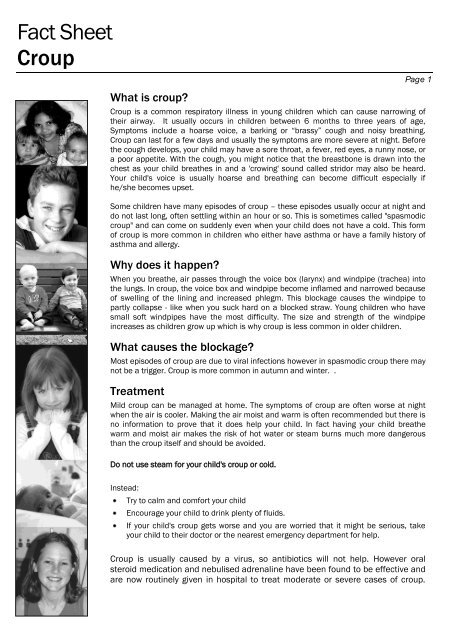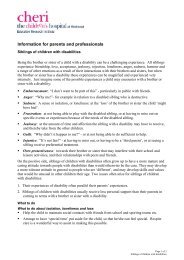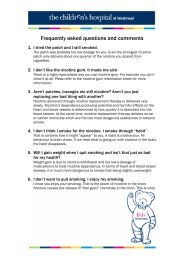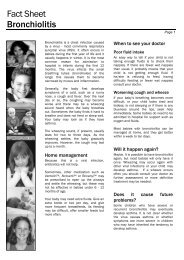Fact Sheet Croup - Kids Health @ CHW
Fact Sheet Croup - Kids Health @ CHW
Fact Sheet Croup - Kids Health @ CHW
You also want an ePaper? Increase the reach of your titles
YUMPU automatically turns print PDFs into web optimized ePapers that Google loves.
<strong>Fact</strong> <strong>Sheet</strong><br />
<strong>Croup</strong><br />
xcvxcvxcv<br />
Page 1<br />
What is croup?<br />
<strong>Croup</strong> is a common respiratory illness in young children which can cause narrowing of<br />
their airway. It usually occurs in children between 6 months to three years of age,<br />
Symptoms include a hoarse voice, a barking or “brassy” cough and noisy breathing.<br />
<strong>Croup</strong> can last for a few days and usually the symptoms are more severe at night. Before<br />
the cough develops, your child may have a sore throat, a fever, red eyes, a runny nose, or<br />
a poor appetite. With the cough, you might notice that the breastbone is drawn into the<br />
chest as your child breathes in and a 'crowing' sound called stridor may also be heard.<br />
Your child's voice is usually hoarse and breathing can become difficult especially if<br />
he/she becomes upset.<br />
Some children have many episodes of croup – these episodes usually occur at night and<br />
do not last long, often settling within an hour or so. This is sometimes called "spasmodic<br />
croup" and can come on suddenly even when your child does not have a cold. This form<br />
of croup is more common in children who either have asthma or have a family history of<br />
asthma and allergy.<br />
Why does it happen?<br />
When you breathe, air passes through the voice box (larynx) and windpipe (trachea) into<br />
the lungs. In croup, the voice box and windpipe become inflamed and narrowed because<br />
of swelling of the lining and increased phlegm. This blockage causes the windpipe to<br />
partly collapse - like when you suck hard on a blocked straw. Young children who have<br />
small soft windpipes have the most difficulty. The size and strength of the windpipe<br />
increases as children grow up which is why croup is less common in older children.<br />
What causes the blockage?<br />
Most episodes of croup are due to viral infections however in spasmodic croup there may<br />
not be a trigger. <strong>Croup</strong> is more common in autumn and winter. .<br />
Treatment<br />
Mild croup can be managed at home. The symptoms of croup are often worse at night<br />
when the air is cooler. Making the air moist and warm is often recommended but there is<br />
no information to prove that it does help your child. In fact having your child breathe<br />
warm and moist air makes the risk of hot water or steam burns much more dangerous<br />
than the croup itself and should be avoided.<br />
Do not use steam for your child's croup or cold.<br />
Instead:<br />
Try to calm and comfort your child<br />
Encourage your child to drink plenty of fluids.<br />
If your child's croup gets worse and you are worried that it might be serious, take<br />
your child to their doctor or the nearest emergency department for help.<br />
<strong>Croup</strong> is usually caused by a virus, so antibiotics will not help. However oral<br />
steroid medication and nebulised adrenaline have been found to be effective and<br />
are now routinely given in hospital to treat moderate or severe cases of croup.
<strong>Fact</strong> <strong>Sheet</strong><br />
<strong>Croup</strong><br />
xcvxcvxcv<br />
This fact sheet is for education purposes only.<br />
Please consult with your doctor or other health professional<br />
to make sure this information is right for your child. This document was last reviewed on 11 th October 2011<br />
The next date of review for this document is 11 th<br />
October 2013.<br />
www.chw.edu.au www.sch.edu.au www.kaleidoscope.org.au<br />
Page 2<br />
These medicines reduce the swelling in your child’s airway and help them to breathe<br />
easier. After treatment most children can be discharged home from the emergency<br />
department without need for admission.<br />
How long does it last?<br />
Generally, croup is worse during the first few days of the illness and may sometimes last<br />
up to a week. The cough usually lasts longer. There will be no permanent damage after<br />
an episode of croup.<br />
When to seek help<br />
If your child has any of the following, go to a doctor or hospital straight away:<br />
breathing is difficult;<br />
your child becomes pale or blue (cyanosed) which usually happens after a coughing<br />
spell;<br />
your child becomes restless, irritable and/or delirious;<br />
you notice the breastbone being drawn in severely;<br />
your child has a high temperature and has increasing dribbling and /or drooling;<br />
your child is not drinking enough;<br />
you become concerned for any other reason.<br />
the “crowing” noise made by your child is heard when they breathe in and out even<br />
when your child is resting.<br />
If you suspect that your child has accidentally inhaled a foreign object<br />
Remember<br />
<strong>Croup</strong> is often a mild illness but can get worse quickly.<br />
<strong>Croup</strong> is often worse at night.<br />
Steam does not help and may lead to accidental burns.<br />
If there is severe breathing difficulty, or, if your child is distressed, contact your<br />
doctor or local hospital.<br />
<strong>Croup</strong> can quickly become serious, so do not hesitate to get medical help.<br />
There is effective treatment for severe episodes of croup.<br />
© The Children’s Hospital at Westmead, Sydney Children’s Hospital, Randwick & Kaleidoscope * Hunter Children’s <strong>Health</strong> Network 2005 – 2011
















